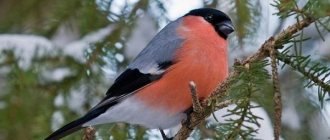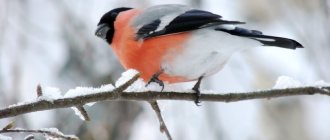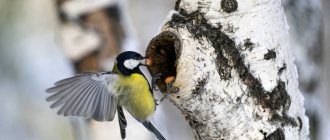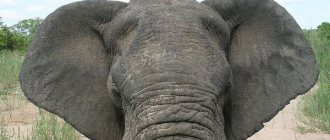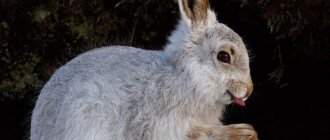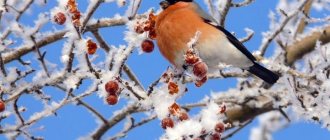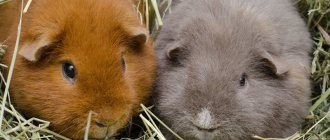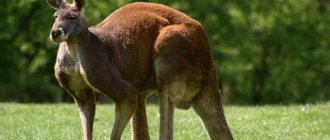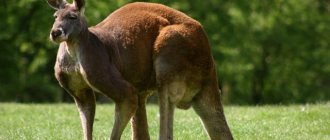- September 1, 2018
- Tips for tourists
- Sergey Nikolaev
The bullfinch (name in Latin - Pyrrhula pyrrhula) is a very small bird, slightly larger than a sparrow. This is a representative of one of the most numerous families of songbirds - the Finches. Other birds of this family are also well known - these are finches, greenfinches, goldfinches, crossbills, lentils, bee-eaters, etc. All of them, in turn, make up the order Passeriformes.
The bullfinch was described more than two hundred years ago by the Swedish naturalist Carl Linnaeus.
What a bullfinch is, what its lifestyle is, what its diet consists of, as well as where this bird lives in summer and where in winter, is described in this article.
Origin of the species and description
Photo: Bullfinch
In summer, few people can notice bullfinches. These are winter birds that have a lot to worry about in warm weather and rarely appear in open spaces. At the same time, in the summer they change their bright color to a paler one, so they are easily camouflaged among the variety of other birds. By winter, these animals transform and become as active as possible. It is impossible not to recognize them - their colors combine several bright colors: black, red, white and bluish-gray. This winter attire makes bullfinches one of the most beautiful birds appearing in winter.
Interesting fact: There are several legends explaining the origin of the bright red chest color of bullfinches. According to one of the most popular, it was this bird that brought fire to people on Earth and along the way it received a burn. However, scientists claim that there is nothing mythical about the red plumage. This color is the result of the red pigment contained in the animal's cells.
The origin of the name “bullfinches” is controversial among many. Some are sure that these animals began to be called that because of their winter lifestyle. Others claim that the name comes from the Latin "Pyrrhula pyrrhula", which translates as "fiery" and refers to the bright breast plumage of the males. There is also a version that the name “bullfinch” comes from the Turkic “snig”, literally meaning “red-breasted”.
Video: Bullfinch
Bullfinches are also called snowbirds. These animals belong to the bullfinch genus of the same name, which is part of the large finches family. To date, scientists have identified several subspecies of such birds.
Of these, only three live in Russia:
- Eurosiberian common. A very common, numerous subspecies. Chooses forest and forest-steppe zones for life;
- Caucasian common. These are very small birds of bright color, distinguished by a short tail, a “swollen” beak;
- Kamchatka common. It is distinguished by its large size; there are always white spots on the tail feathers. Males have a pink breast.
Summer time
Many people may be interested in the question of where bullfinches fly in the summer and whether they fly away at all. So, it may seem to some that, following the principle of migratory birds, they can go to colder regions. But this is absolutely not true. The bullfinch, by its nature, is a sedentary bird, and in the summer it simply hides from human gaze, hiding in dense forests and thickets. However, it should be said that bullfinches still fly away for the summer from cities and densely populated areas to more secluded places. They make nests in the dense branches of deciduous trees or on the highest branches of fir trees where no one can reach or see them. Therefore, in the summer it is quite difficult to observe these birds, because they skillfully hide from humans, practically without giving themselves away.
Appearance and features
Photo: Bullfinch bird
Attractive appearance is the hallmark of bullfinches. Photos of these birds are extremely popular - they are often published in magazines, newspapers, books, on beautiful New Year cards, and calendars. Snowbirds are small in size. They are only slightly larger than their closest relatives, the sparrows.
The body length is only eighteen centimeters, the wingspan is thirty centimeters. The body itself has a dense structure and strong muscles. However, the bird's weight is small - thirty-five grams. Bullfinches have pronounced sexual characteristics - it is quite easy to distinguish a male from a female.
There are two signs:
- males are distinguished by bright plumage on the chest. Their breasts are always bright red. Only some subspecies have a slightly different color;
- The female's breast is decorated in gray. At certain angles, a slight pinkish tint may be visible.
Otherwise, males and females are endowed with the same feather color. The head of the animal is black, the back is gray-bluish. The wings are black and white. Due to the alternation of black and white feathers, the bird's wings look very bright and unusual. In young animals, the body color is always paler. It only becomes brighter with age.
Bullfinches have a very short tail. It is slightly rounded at the end. The upper tail feathers are black, the lower ones are white. The bird also has a small, wide beak. The paws are also small, but quite strong and durable. Each paw has three toes with sharp claws. This structure of the legs allows bullfinches to hold tightly to the bark of trees and small branches.
Why can bullfinches and tits only be seen in winter?
Small representatives of the passerine order are forced to devote almost all their time to searching for food. In summer, the task of obtaining food is not difficult to solve, since edible insects and seeds are found literally at every step. In winter, it becomes more difficult to live in forests and gardens, so birds move closer to human habitation. It’s easier to find food here, since people constantly throw away bread cores and hang bird feeders, and it’s not so difficult to find a warm place to sleep somewhere under a roof.
At the end of the winter cold, when the earth begins to wake up and various bugs and spiders crawl to the surface, tits and bullfinches migrate from cities closer to nature - to nearby forests, gardens and parks. There, among the green foliage, in secluded places, they build nests, incubate the laid eggs, and then take care of the offspring.
Only an attentive observer will be able to notice a small tit or a nimble bullfinch in the dense branches. That is why it seems to us that in the summer birds fly away somewhere from our region, although in fact they are just changing their habitat.
Where does the bullfinch live?
Photo: Red Bullfinch
Snowbirds are small, common birds. They are distributed almost all over the world, with the exception of very hot countries. Such animals live in Europe, Asia, Russia, Ukraine, Japan. Individual populations can be found in Greece, Asia Minor, and Spain. Such birds are suitable for a temperate climate, with obligatory coolness in winter. It is in winter that bullfinches prefer to be active.
Snowbirds choose lowland, mountain forests to live. They are practically not found in treeless areas. Animals that live near cities spend a lot of time in public gardens and parks in winter. Bullfinches can be called sedentary birds. They choose an area for themselves, build nests there and live almost their entire lives in one place. In summer, even in places with large concentrations of bullfinches, it is difficult to notice them. In winter, these animals unite in huge flocks, become very noticeable, and change their color to a brighter one.
Only some subspecies of bullfinches periodically change their place of residence. We are talking about adult individuals living in the northern regions of their natural habitat. When severe cold comes, these birds turn into nomads. They move south, where winter also comes with their appearance.
Now you know where the bullfinch bird lives. Let's see what this bright winter bird eats.
Natural habitats
The bullfinch bird is found almost throughout Europe, Asia, as well as in Siberia, Kamchatka and Japan. The southern borders of its habitat run across northern Spain, the Apennines, Greece, and Asia Minor. In our territories, bullfinches live from west to east, preferring forest and forest-steppe zones with the presence of coniferous trees. Moreover, they are found both in flat areas and in the mountains, with the obligatory presence of forest plantations.
In addition to forests and dense undergrowth, these birds nest in city gardens, parks and squares. This is especially true in relation to seasonal migrations. In summer, the bullfinch can be seen in dense thickets, as well as in open forests. Bullfinches generally lead a sedentary lifestyle, but they migrate from the northern regions of the taiga with the onset of winter cold. The habitats of these birds extend to the territory of Eastern China, as well as Central Asia.
What does a bullfinch eat?
Photo: Bullfinch in winter
Bullfinches cannot be called omnivores. They eat a limited range of foods. The most favorite delicacy of these tiny birds is rowan. Many people know about this fact, because bullfinches are often depicted in pictures together with bright red mountain ash. Birds feed in flocks on rowan trees. They choose the tree with the most berries, and they all sit together on one branch. During feeding, males show their gentlemanly qualities. They always let their ladies go first. Thus, females have the opportunity to choose large, ripe, tastiest berries.
However, these animals do not eat the pulp of the rowan berries. Of these, they prefer to take only seeds. These birds also love to eat the seeds of other trees. They choose maple, ash, alder, elderberry, and hornbeam. They fly out in flocks in search of suitable food. It is impossible not to notice the bullfinches; they literally cover the entire tree.
In summer, the diet of snowbirds is wider. In addition to seeds of various trees, it begins to include plant seeds. These birds eat burdock, horse sorrel, and quinoa. Many other field grasses are also commonly eaten. Quite rarely, the diet of bullfinches begins to include protein food in the form of various small insects.
Interesting fact: It is no secret that snowbirds are very nimble, fast and dexterous birds. However, during feeding they are very clumsy. This leads to the fact that the birds do not notice the danger and become victims of attacks by domestic and predatory animals.
Bird food
Having figured out where bullfinches disappear in the summer, it’s worth saying a few words about what this breed of bird eats . Some of the conclusions about their diet can be made just by looking at their beak. It is very massive, which means it is designed to tear small nuts or seeds. However, such a beak is completely unsuitable for catching bugs and worms. Birds prefer to eat various berries, of which they eat only the seeds, and simply throw away the pulp and buds of trees.
Features of character and lifestyle
Photo: Bullfinch on a branch
Bullfinches can safely be called forest dwellers. Birds spend most of their time in trees, forest clearings, and densely planted parks. Among a wide variety of tree species, these animals choose needles. However, they can also live in mixed forests. If previously bullfinches lived, reproduced and fed exclusively away from humans, now they have become bolder and often appear near residential buildings. They can be seen in parks, in the courtyards of apartment buildings, and in public gardens.
They are often forced to fly closer to human settlements by the need for food. In the forests, especially in winter, it is difficult to find enough suitable food. In the city, people hang out feeders for small birds. There are also a lot of rowan trees in the city, which store berries in winter. Despite the fact that bullfinches have become frequent guests in cities, towns, and villages, they cannot be called city birds. These are exclusively forest animals.
The lifestyle of bullfinches depends on the time of year. In winter, these birds are most active. They fly in large flocks from one tree to another in search of seeds. In smaller groups, snowbirds appear near the feeders. It is not difficult to see bullfinches - against the background of white snow they look like beautiful Christmas tree decorations. The bright breasts of males make them stand out from other birds. In summer, the animals' lifestyle becomes calmer. The color of their feathers fades, the birds begin to spend more time in the forests, taking care of the home and their offspring.
The character of snow birds is docile and calm. These are leisurely, balanced, cheerful birds. They always show accuracy and prudence. They rarely become involved in fights. Bullfinches can be domesticated. These animals easily get used to their owner, know how to show gratitude for food, and can become almost tame.
Interesting fact: In Rus', bullfinches were one of the most popular birds for home keeping. They were often called "Russian parrots". The animals earned this nickname due to their special talent for imitating various sounds.
Why are bullfinches closer to people in winter?
Having figured out whether bullfinches fly to colder regions for the summer, it is also worth saying a few words about why these birds are drawn to crowded places in winter. It's simple: in search of food. For birds, the worst thing is not the cold (after all, their temperature, on average, is 41-42 degrees), but hunger. Lack of food has a bad effect on the body of birds, they freeze faster, and even a healthy bird can die. At this time, it is very difficult to find food in the forest, so bullfinches fly to where there are people and where they can profit from something. The most difficult time for these birds is when the daylight hours are shortest - in December-January, which is when you can see the first bullfinches on city streets. When food can be easily found in the thicket of the forest, the birds return to a more convenient environment for them, leaving crowded cities and towns.
Social structure and reproduction
Photo: Red Bullfinch
The mating season of bullfinches goes as follows:
- the season begins with a change in the behavior of males. Birds become more courteous, their voice sounds more pleasant and melodic. Males begin to dedicate their songs to females, and they begin to choose a suitable partner. Pairs are formed only in March;
- The next stage can be called nest construction. The male and the female begin selecting a suitable place and collecting materials. Most often, these animals build houses on spruce forests. They are placed high enough and away from the trunk. So they try to protect their future offspring from predators as much as possible. To build a nest, birds use dry grass, twigs, lichen, animal hair, and dry leaves;
- in May, the couple produces eggs, which will then hatch into little bullfinches. There are not many eggs in one clutch - about six. They are quite bright, blue in color with brown specks. The incubation process takes about two weeks;
- Bullfinches chicks are born very tiny, helpless. Their only strong quality is the feeling of hunger. Parents have to work all day to feed their offspring enough.
Interesting fact: Despite their helplessness, bullfinches chicks have fairly good health and wide natural potential. They are developing at tremendous speed. Within a few weeks after birth, the chicks learn to fly, and after another two weeks they can lead a completely independent lifestyle.
Males and females
Females and males have distinctive plumage features. The physique, size, and structural features are absolutely the same. Females are not so intensely red, but may only have a scarlet tint on the abdomen. The female has a light brown chest, cheeks and belly. There are also differences in the distribution of roles in the family. The female completely alone accompanies the process of incubation and hatching of eggs. The male, in turn, is engaged in obtaining food.
Photo of a female and a male
Natural enemies of bullfinches
Photo: Bullfinch bird
Bullfinches, unfortunately, often suffer due to their bright and noticeable color. Unlike other birds, these animals are more often victims of attacks. The reason for this can also be attributed to the natural slowness of bullfinches. During feeding, these birds behave carelessly and imprudently. Who attacks the snowbirds?
There are several of the most dangerous natural enemies:
- predator birds. It is not difficult for such animals to catch a small, plump bullfinch. They are attacked by owls, hawks, and eagle owls;
- medium-sized predatory animals. Bullfinches can die from the paws of martens, foxes, and wild cats. Bullfinches' nests are often destroyed by squirrels;
- Pets. By eating seeds in clearings or in special feeders within the city, bullfinches run the risk of becoming easy prey for domestic animals. They are often attacked by cats;
- fleas, parasites. Such enemies lie in wait for birds mainly in the nest. They negatively affect the health of animals, cause them to develop various diseases and even lead to death.
Interesting fact: Bullfinches are quite smart birds. They know they are putting themselves in danger while feeding. To protect themselves at least a little, the birds unite in large flocks. A flock can consist exclusively of bullfinches or even other birds: finches, thrushes. In case of danger, members of the pack give a signal to all other members. Therefore, little bullfinches have a chance to quickly leave an unsafe place without becoming a victim of a predator.
Human influence on the bullfinch population
Over the past decade, bullfinches have turned from common birds into rare ones. This is due to the fact that humans deprive birds of their living space, which leads to their death. The population of this bird species is influenced by the following factors:
- human development of forest spaces, massive cutting down of trees;
- deterioration of the environmental situation;
- deterioration in the quality of forest plantations.
Poor ecology and regular deforestation leave bullfinches without food. This leads to their mass death. On thematic forums, the question is often asked where the bullfinches have gone, since there are much fewer of them in city parks and squares during the cold season.
Is the bird in the Red Book
Today the bullfinch is listed in the Red Book. According to the experts who conducted the research, he is listed on the “least concern” scale.
Bullfinch in flight
What does a bullfinch bird look like?
The bullfinch (Pyrrhula pyrrhula) is a winter bird, so it is almost impossible to admire its beautiful appearance in summer. ... But in winter, male bullfinches look very impressive. Their wings, head and tail are painted deep black. The back and part of the neck are bluish-gray, the undertail and rump are white.
Interesting materials:
How to see cardinal directions on a map? How to save to a memory card on Meiza M6? How to find a memory card on Redmi? How to save to a memory card on a Samsung J2? How to transfer applications to a memory card on Samsung G 2? How to switch to a memory card on a Samsung J2 Prime? How to transfer WhatsApp to a memory card on Samsung? How to pay with a card on Samsung? How to save contacts to a SIM card on Samsung? How is interest calculated on the balance on a bank card?
